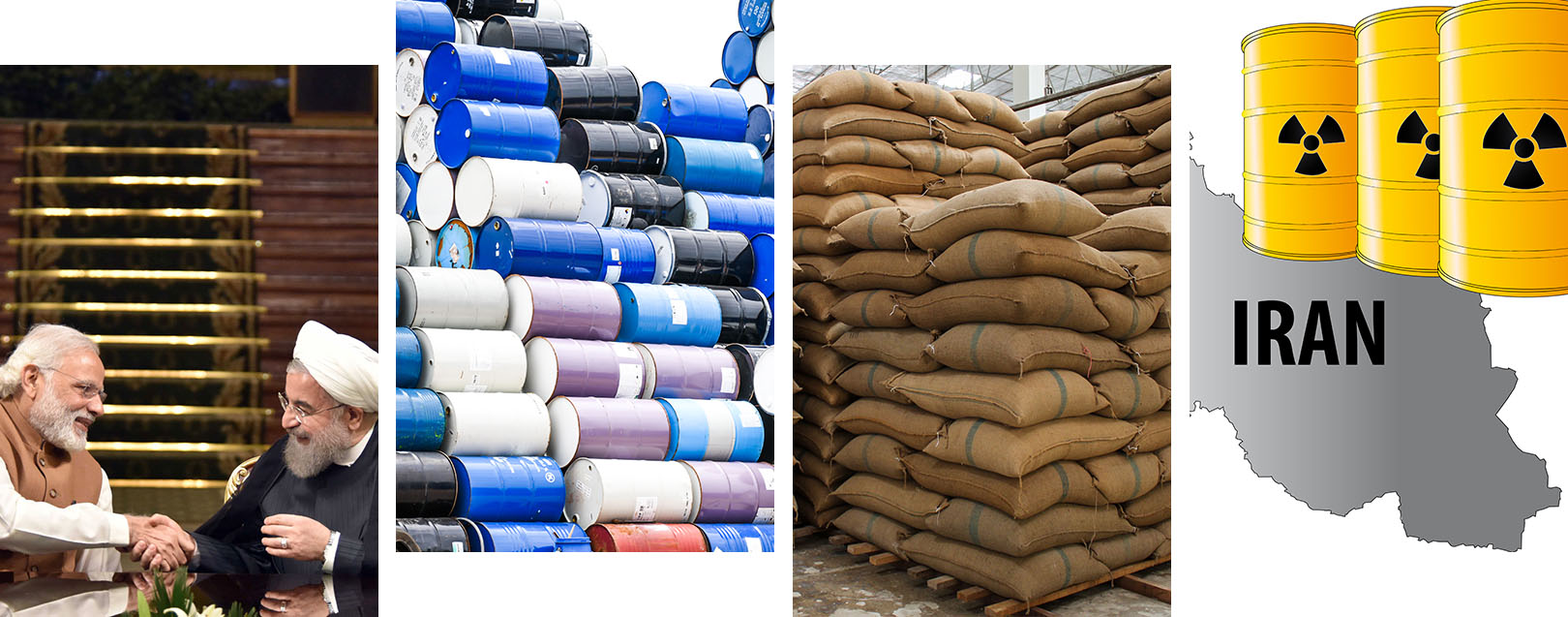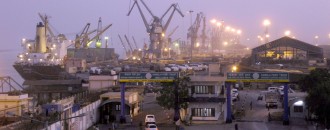
Oil, Rice, Chabahar: India-Iran trade issues demystified
Sneha Gilada
Economically tied with high volume trade in crude oil and politically tied with similar interests for stability in the Middle East, especially Afghanistan, India and Iran have traversed a long and tumultuous journey to maintain a healthy trade relationship. In an interview with Hon. Consul General, Hassan Nourian (HN), Consulate General of the Islamic Republic of Iran, Hyderabad; The Dollar Business (TDB) explores current issues in the India-Iran bilateral relationship. Speaking about diverse areas from the ambiguity in payment settlement mechanisms to problems in basmati rice exports, the diplomat lucidly explains the dynamics in India-Iran relations.
India-Iran payments settlement issues
To ensure smooth trade relations between India and Iran regardless of a series of international and American sanctions imposed against the middle-eastern nation, a rupee denominated payment mechanism was in place for years. When economic sanctions were lifted in 2015, Iran’s preference towards the use of more convertible currencies like Euro for cross-border trade left its rupee account depleted. The expiration of this long-running payment system caused some stress in trade relations between the two countries.
TDB: How are the unresolved issues in payments settlement between India and Iran being dealt with?
HN: The JCPOA (Joint Comprehensive Plan of Action) opened banking routes for Iran, and caused the old payment mechanism to become defunct. Opening up of SWIFT (a secure exchange network for inter-bank transactions) to Iranian banks has supplemented current payment methods. Minor issues still exist between Iran and India, which are in the process of being resolved.
Some of the Iranian banks have submitted proposals to the RBI asking for permits to open branches in India, particularly Parsian and Pasargad. Opening up of branches in India will go a long way in introducing ease in business between the two countries.
TDB: Iran seems apprehensive in the use of dollar for foreign trade. Which currency is being used currently?
HN: There are different categories of sanctions, some imposed internationally and others specifically by the government of USA. The newly imposed international sanctions have been lifted recently by the United Nations Security Council, but the old American sanctions are not among these international sanctions.
The government of Iran is interested in diversifying its use of various currencies for foreign trade. With many countries, transactions are made in their respective currency, for instance, Yuan with China and Euro with the EU.
Chabahar Port – India’s key to Central Asia
Within a few months of the nuclear deal, India made significant headway in furthering India-Iran partnership by extending support in the development of Chabahar port. The transport-and-trade corridor project meant to connect the two nations via Afghanistan is said to halve the costs and time of India’s reach to Europe and Central Asia for trade purposes. The move is likely to help India bypass Pakistan (creating an unencumbered trade route to territories beyond the troubling neighbour) and counter China’s growing influence in Central Asia.
TDB: What is the strategic significance of Chabahar port for India and Iran?
HN: India, Iran and Afghanistan signed a tripartite agreement last year, during the visit of PM Narendra Modi’s visit to Tehran, to develop the Chabahar port into a transit hub. India has committed to a $500 million investment for the same.
Until 1947, Iran and India were neighbouring countries. Since the separation of Pakistan, India has not had a direct trade route connecting it with Central Asia and Afghanistan. Easy trade access to Central Asia is the prime strategic reason behind India’s investment in Chabahar port.
Chabahar is not only an economically beneficial area but also an important strategic area. Through investments from countries like India, Iran hopes to bring about the development of many undeveloped villages and cities in the Chabahar region.
TDB: What is India’s role in bringing stability to Central Asia, weighed down by terrorism and extremism?
HN: Our region is suffering from problems of extremism. Afghanistan, due to an unstable and weak government is a breeding ground for terrorist groups to emerge and grow. Poverty and a weak economy are the root causes for the emergence of extremism.
Empowering business environment and economy in these regions can help secure the region from growing terrorism, and that is why investment in the Eastern part of Iran (Chabahar), which will provide a direct link to Afghanistan and Pakistan, may help empower small groups of people with productive tools of education and business, cutting off their ties to extremist ideologies. Japan and China have also expressed interest in investing in the Chabahar region.
India-Iran trade in Basmati Rice
The last few months of 2016 saw Indian basmati rice exporters fret over multiple import barriers and price restrictions imposed by Iran, one of India’s largest export destinations for basmati rice. A total quantity of 4.05 million tonnes exported in 2015-16 is expected to drop to 3.8 million tonnes in 2016-17 due to a drop in the quantity imported by Iran.
“The India-Iran basmati rice issue is a technical one, not a political one,” the Consul General said, taking cognizance of India’s basmati rice export concerns.
TDB: What are the supply-demand statistics of basmati rice in Iran?
HN: The per capita consumption of basmati rice in Iran currently stands at 37kg – 40kg annually, or 104 g per day. While Iran’s annual production of basmati rice averages 1.8 million - 2 million tonnes, the consumption is around 3 million tonnes. To fill in for this deficit between demand and supply, Iran imports rice to the tune of 1 million tonne every year, mostly from India.
TDB: What is India’s share in Iran’s total import of basmati rice?
HN: The quality of Indian Basmati rice (1121 is Iran’s preferred kind of basmati rice) is ideal and suitable for Iranian consumption. As much as 700,000 tonnes of the Iranian annual basmati rice imports is sourced from India. Pakistan, Thailand, Vietnam and other European and Latin American countries account for the remaining 30% imports.
Many other countries are competing for India’s massive share in the pie. India must keep its prices competitive to secure its edge.
TDB: Why has the Rice Importer’s Association in Iran capped import prices at $850/tonne?
HN: A price hike of 50% in October 2016 caused Indian exporters to demand high prices ($950/tonne) for their produce. This compromised affordability for the Iranian citizen.
Iran has off-late cut down import tariffs on rice from 40% to 26%, to boost affordability. With the same objective, the Iranian Government recommends a price cap of $850/tonne for rice imports.
TDB: Why does Iran temporarily ban rice imports for a few months every year?
HN: Iran imposes import restrictions not only on rice but on all agricultural products during their respective domestic harvest season. Averaging 3-4 months, the temporary barring of imports is a policy common to all of Iran’s agricultural produce.
TDB: What are some other concerns regarding basmati rice trade between India and Iran apart from prices and temporary import restrictions?
HN: India’s negligence in meeting quality standards raised a few red flags at Iran’s Health Ministry. Instances of some Indian samples being laced with arsenic had aroused some quality concerns.
To override the triple hurdles of quality, price hike and seasonal import restrictions, a trade delegation from India had visited Iran in January 2017. During the high-profile visit, India invited Iran for laboratory visits to perform quality checks.
India-Iran trade beyond crude
Iran is the third-largest exporter of crude oil to India after Saudi Arabia and Iraq. Consistent oil trade over the years has also contributed significantly to friendly India-Iran relations, despite stringent international sanctions on the economy. In the first 10 months of the fiscal year 2016-17, India imported crude worth $6.8 billion from Iran, making up for about 12% of India’s total crude import during the same period.
TDB: What impact will the oil price rise (due to the OPEC deal) have on India-Iran trade?
HN: India, being a fast-developing nation, has a very high demand for energy (India’s crude oil imports grew 7.6% in quantity from 2014-15 to 2015-16). Complementing this need, Iran is the most stable and resourceful country in the region for India to import oil reliably from.
Due to a drop in global prices of oil, the India-Iran trade volume dropped from $13 billion in 2015 to $9 billion in 2016, despite an increase in the volume of oil imports by India from Iran. We do not wish for our economy to rely excessively on oil exports. With this objective, Iran has adopted the policy of a resistance economy.
TDB: India-Iran trade is mostly confined to crude oil. What are some other areas of focus for increasing bilateral trade between the two nations?
HN: More than 70% of the India-Iran trade is currently in crude oil. Rice, dal and other edibles make up for most of the remaining trade volume. Iran would like to go beyond this traditional trade relationship and engage with India in advanced sectors like IT, aerospace, biotechnology and pharmaceuticals.
Hyderabad has immense potential for both industries, pharma and IT. About 70% of India’s manufacturing capacity in pharmaceuticals is housed in Hyderabad. In fact, Chennai, Hyderabad and Bangalore are three of the Southern IT hubs which fall under our jurisdiction.





